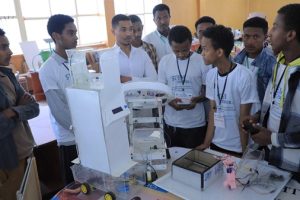BY MENGISTEAB TESHOME
School feeding program, as documents indicate, introduced in Ethiopia in 1994 by World Food Program (WFP) in collaboration with the Ethiopian Government, regional education bureaus and communities by providing one hot meal composed of corn soya blend, vegetable oil, and salt.
At that time, the program has been carried out in areas vulnerable to food insecurity due to drought and other factors to help students to attend school regularly and be mentally and physically healthy.
The intervention later added a take-home ration for girls in the pastoralist area. Until the introduction of the Home-Grown School Feeding (HGSF) in 2012, WFP Ethiopia has been implementing the school feeding program through the traditional method of providing porridge made from Corn-Soy Blend (CSB) mostly secured from the in-kind donation.
Currently, the Addis Ababa City Administration by expanding its scope and magnitude is working untiringly to address the challenges of low-income and homeless individuals, support them meaningfully and ease their burden. Especially, aside from limited in schools and school children, it is undertaking exemplary activities in tackling urban poverty by devising various pro-poor projects.
As many people utter, Administration’s feeding program (school feeding and daily rations for impoverished ones) in the capital has given relief to millions of low-income households and less privileged groups. The program has impacted the lives of the underprivileged segment substantially.
Of late, the Administration announced the opening of the third feeding center in Addis Ketema Sub City with the aim to provide a meal at least once in a day for vulnerable people residing in the capital.
The first two feeding centers also known as ‘Rays of Hope Feeding Centers’ have been operational in Bole and Arada sub cities, each providing a meal service for 1000 people a day.
The opening of the feeding centers signifies the value of humanity surviving among the community and the government. Despite providing meals the centers had created hope and job opportunities for the residents.
The Ethiopian Press Agency approached some of the beneficiaries to share their experience. Semira Hassan is one of the beneficiaries of the program. As she stated, she is earning her income by engaging in the center. “Even though I travelled abroad seeking a better payment to improve my own and family’s life and spent years there, I could not meet my expectations for various reasons. Sadly, I end up being jobless,” she said.
According to her, thanks to the job opportunity created in the Arada Sub City at Hope Feeding Center, she is working as coordinator at the center. The job apart from enabling her to support herself, it has allowed her to help others; and she is happy for that.
“The Center has enabled me to learn the extent of hardships, sufferings, challenges and inopportuneness that vulnerable and street children encounter in their day to day life. Serving this segment of the population gives me high satisfaction because I have passed through with this same experience,” she added.
“I had gone through a number of challenges. There were times I stayed in bed for days falling sick. There were also times that I had frustrated and tried to find some help from others. Some of the responses I received were both positive and negative for various reasons.”
As to her, it is not with payment, but serving and giving care freely for those people who are leading a miserable life, sharing their burden, their sufferings and pains offers psychological satisfaction.
There is nothing as thrilling as seeing people, who were once destitute; and receiving support, improving their lives; and in turn supporting others. This truly is source of joy for everyone.
Mentioning her happiness for serving the needy, she appreciated those who came up with the idea of the food center because they realized what it means to live for fellow citizen and the country.
Abriham Miskir is the other beneficiary of the meal program at the Center. At his young age, 18, he took part at The Ogaden War (the Ethio-Somali War) and wounded which later compelled him to depart the national defense force. And for the past forty years, he has been wandering on the streets of Addis Ababa leading a vulnerable lifestyle.
While talking about the Center, Abraham said that the assistance they get from the Center is beyond words. “I have no words how the feeding center is benefiting us. In general term, it is a lifesaving center. For instance, apart from the materials it supplies us during holidays such as clothing, hygienic materials, as well as bathing, barbering and shaving services; it is keeping us from starvation. “At regular basis, we dine and leave to our places happily.”
Abraham said that he is pleased to see a government that tries to address the concern of vulnerable communities in this testing time.
According to him, when the Mayor Adanech Abeibei stated about the idea of launching feeding center, he was skeptical for the reason there are huge number of needy in the capital. Is it possible to feed such a large number of needy, how it could happen and how it could be managed; he was asking himself. However, all turned to reality within few months. “I am cheerful; this has proven the productivity of the program.”
“In earlier times, I used to eat when possible or slept on an empty stomach without having a meal. However, currently, the Center has alleviated my problem and feeding me regularly,” said Almaz Miheretu, the other beneficiary.
“The Center has secured me from begging on the roadside. I have also witnessed how our fellow citizens are considerate and compassionate for us. The feeding center has given me relief. I am happy with the services,” she added.
Meanwhile, Addis Ababa City Feeding Agency has announced plan to double the number of community feeding centers and the number of people benefitting from the feeding program.
According to Anchinesh Tesfaye, Agency’s Director General, the City Administration has set plan to double the number of community feeding centers in the capital in the next two months.
As the Director General told to EPA, increasing the number is part of City Administration’s target of accomplishing tasks within the next 60 days.
Mentioning that there are six community feeding centers under the city administration, she said through these centers, more than 10,000 citizens are receiving daily food service.
“In the next two months, we are working to feed over 20,000 by increasing the number of centers to 12,” she remarked.
According to a study conducted by the City Administration, over 100,000 people do not get a meal once in a day.
THE ETHIOPIAN HERALD FRIDAY 1 JULY 2022





